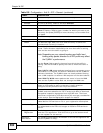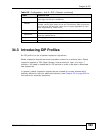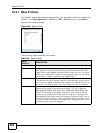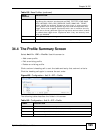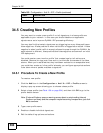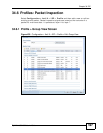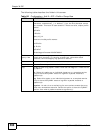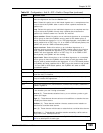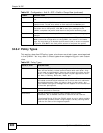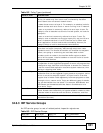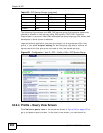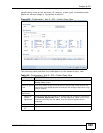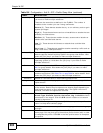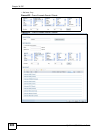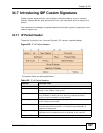
Chapter 34 IDP
ZyWALL USG 300 User’s Guide
600
34.6.2 Policy Types
This section describes IDP policy types, also known as attack types, as categorized
in the ZyWALL. You may refer to these types when categorizing your own custom
rules.
Log These are the log options. To edit this, select an item and use the Log
icon.
Action This is the action the ZyWALL should take when a packet matches a
signature here. To edit this, select an item and use the Action icon.
OK A profile consists of three separate screens. If you want to configure just
one screen for an IDP profile, click OK to save your settings to the
ZyWALL, complete the profile and return to the profile summary page.
Cancel Click Cancel to return to the profile summary page without saving any
changes.
Save If you want to configure more than one screen for an IDP profile, click
Save to save the configuration to the ZyWALL, but remain in the same
page. You may then go to another profile screen (tab) in order to complete
the profile. Click OK in the final profile screen to complete the profile.
Table 161 Configuration > Anti-X > IDP > Profile > Group View (continued)
LABEL DESCRIPTION
Table 162 Policy Types
POLICY TYPE DESCRIPTION
P2P Peer-to-peer (P2P) is where computing devices link directly to each
other and can directly initiate communication with each other; they
do not need an intermediary. A device can be both the client and the
server. In the ZyWALL, P2P refers to peer-to-peer applications such
as e-Mule, e-Donkey, BitTorrent, iMesh, etc.
IM IM (Instant Messenger) refers to chat applications. Chat is real-time,
text-based communication between two or more users via networks-
connected computers. After you enter a chat (or chat room), any
room member can type a message that will appear on the monitors of
all the other participants.
SPAM Spam is unsolicited “junk” e-mail sent to large numbers of people to
promote products or services.
DoS/DDoS The goal of Denial of Service (DoS) attacks is not to steal
information, but to disable a device or network on the Internet.
A Distributed Denial of Service (DDoS) attack is one in which multiple
compromised systems attack a single target, thereby causing denial
of service for users of the targeted system.



